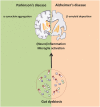Of Microbes and Minds: A Narrative Review on the Second Brain Aging
- PMID: 29552561
- PMCID: PMC5840854
- DOI: 10.3389/fmed.2018.00053
Of Microbes and Minds: A Narrative Review on the Second Brain Aging
Abstract
In recent years, an extensive body of literature focused on the gut-brain axis and the possible role played by the gut microbiota in modulating brain morphology and function from birth to old age. Gut microbiota has been proposed as a relevant player during the early phases of neurodevelopment, with possible long-standing effects in later life. The reduction in gut microbiota diversity has also become one of the hallmarks of aging, and disturbances in its composition are associated with several (age-related) neurological conditions, including depression, Alzheimer's disease, and Parkinson's disease. Several pathways have been evoked for gut microbiota-brain communication, including neural connections (vagus nerve), circulating mediators derived by host-bacteria cometabolism, as well as the influence exerted by gut microbiota on host gut function, metabolism, and immune system. Although the most provoking data emerged from animal studies and despite the huge debate around the possible epiphenomenal nature of those findings, the gut microbiota-brain axis still remains a fascinating target to be exploited to attenuate some of the most burdensome consequences of aging.
Keywords: Alzheimer; Parkinson; brain development; gut metabolism; gut microbiota; gut–brain crosstalk; inflamm-aging; neurological disorders.
Figures



Similar articles
-
The Microbiota-Gut-Brain Axis.Physiol Rev. 2019 Oct 1;99(4):1877-2013. doi: 10.1152/physrev.00018.2018. Physiol Rev. 2019. PMID: 31460832 Review.
-
Gut instincts: microbiota as a key regulator of brain development, ageing and neurodegeneration.J Physiol. 2017 Jan 15;595(2):489-503. doi: 10.1113/JP273106. Epub 2016 Dec 4. J Physiol. 2017. PMID: 27641441 Free PMC article. Review.
-
Early nutrition and gut microbiome: interrelationship between bacterial metabolism, immune system, brain structure, and neurodevelopment.Am J Physiol Endocrinol Metab. 2019 Oct 1;317(4):E617-E630. doi: 10.1152/ajpendo.00188.2019. Epub 2019 Jul 30. Am J Physiol Endocrinol Metab. 2019. PMID: 31361544 Review.
-
The Role of the Microbiota-Gut-Brain Axis in the Health and Illness Condition: A Focus on Alzheimer's Disease.J Alzheimers Dis. 2021;81(4):1345-1360. doi: 10.3233/JAD-201587. J Alzheimers Dis. 2021. PMID: 33935086 Review.
-
The impact of gut microbiota on brain and behaviour: implications for psychiatry.Curr Opin Clin Nutr Metab Care. 2015 Nov;18(6):552-8. doi: 10.1097/MCO.0000000000000221. Curr Opin Clin Nutr Metab Care. 2015. PMID: 26372511 Review.
Cited by
-
Targeting Impaired Antimicrobial Immunity in the Brain for the Treatment of Alzheimer's Disease.Neuropsychiatr Dis Treat. 2021 May 4;17:1311-1339. doi: 10.2147/NDT.S264910. eCollection 2021. Neuropsychiatr Dis Treat. 2021. PMID: 33976546 Free PMC article. Review.
-
Impact of Environmental Pollutants on Gut Microbiome and Mental Health via the Gut-Brain Axis.Microorganisms. 2022 Jul 19;10(7):1457. doi: 10.3390/microorganisms10071457. Microorganisms. 2022. PMID: 35889175 Free PMC article. Review.
-
Functional roles of the microbiota-gut-brain axis in Alzheimer's disease: Implications of gut microbiota-targeted therapy.Transl Neurosci. 2021 Dec 28;12(1):581-600. doi: 10.1515/tnsci-2020-0206. eCollection 2021 Jan 1. Transl Neurosci. 2021. PMID: 35070442 Free PMC article. Review.
-
Modulation of the NOD-like receptors NOD1 and NOD2: A chemist's perspective.Bioorg Med Chem Lett. 2019 May 15;29(10):1153-1161. doi: 10.1016/j.bmcl.2019.03.010. Epub 2019 Mar 8. Bioorg Med Chem Lett. 2019. PMID: 30890292 Free PMC article. Review.
-
Shattering the Amyloid Illusion: The Microbial Enigma of Alzheimer's Disease Pathogenesis-From Gut Microbiota and Viruses to Brain Biofilms.Microorganisms. 2025 Jan 5;13(1):90. doi: 10.3390/microorganisms13010090. Microorganisms. 2025. PMID: 39858858 Free PMC article. Review.
References
Publication types
LinkOut - more resources
Full Text Sources
Other Literature Sources

